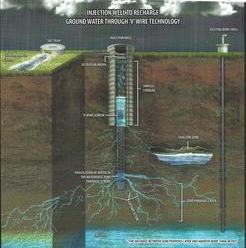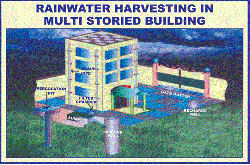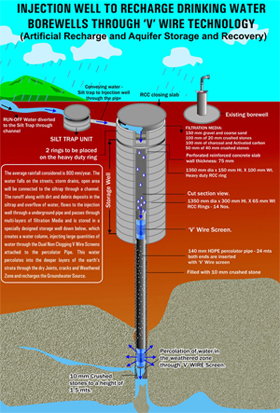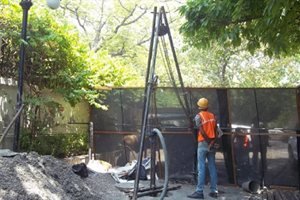For conservation and harvesting, rain water in order to recharge the alarmingly receding ground water tables. Our expertise lies in offering customers Rain Water Harvesting Systems that comprises collection & storage of rain water for different needs. This collected rainwater is stored & subsequently used for meeting the irrigation demands of domestic as well as agricultural applications. Further, these can also be used for recharging ground water.

Artificial recharge is the planned, human activity of augmenting the amount of groundwater available through works designed to increase the natural replenishment or percolation of surface waters into the groundwater aquifers, resulting in a corresponding increase in the amount of groundwater available for abstraction. Although the primary objective of this technology is to preserve or enhance groundwater resources, artificial recharge has been used for many other beneficial purposes. Some of these purposes include conservation or disposal of floodwaters, control of saltwater intrusion, storage of water to reduce pumping and piping costs, temporary regulation of groundwater abstraction, and water quality improvement by removal of suspended solids by filtration through the ground or by dilution by mixing with naturally-occurring groundwaters (Asano, 1985). Artificial recharge also has application in wastewater disposal, waste treatment, secondary oil recovery, prevention of land subsidence, storage of freshwater within saline aquifers. Groundwater recharge methods are suitable for use in areas where aquifers exist. Typically, unconfined aquifers are recharged by surface injection methods, whereas confined aquifers are generally recharged through subsurface injection. Surface injection methods require relatively flat or gently sloping lands, while topography has little effect on subsurface recharge methods. Aquifers best suited for artificial recharge are those which can absorb and retain large quantities of water. In temperate humid climates, the alluvial areas which are best suited to artificial recharge are areas of ancient alluvium, the buried fossil river-beds and interlinked alluvial fans of their main valley and tributaries. In the arid zone, recent river alluvium may be more favourable than in humid zones. In these areas, the water table is subject to pronounced natural fluctuations. Surface recharge methods are best suited to these cases. Coastal dunes and deltaic areas are also often very favourable areas for artificial recharge schemes. Dense urban and industrial concentrations in such areas may render artificial recharge schemes desirable, generally using subsurface recharge wells to inject surface water into the aquifers. Advantages As surface water augmentation methods, such as dams and diversions, have become more expensive and less promising in terms of environmental considerations, the prospects of storing surplus surface water underground and abstracting it whenever and wherever necessary appears to be more effective technology. In urban areas, artificial recharge can maintain groundwater levels in situations where natural recharge has become severely reduced
Rainwater Harvesting Systems We offer services for Rainwater Harvesting through our immense expertise and know how of rain water harvesting. Empowered with experts, we have completed full fledged projects for some of the most reputed organizations like Parsvnath Developers Limited, Unitech Limited, Alcatel India Limited, etc. The rainwater harvesting includes collection, storage and efficient use of rainwater, which reduce the cost of public water supply. The benefits of Rainwater Harvesting can include: Relief of strain on other water supply Ability to build or farm in areas with no other water supply Cleaner water Increased independence and water security Lower water supply cost Reduced flood flows Reduced topsoil loss Improved plant growth Greater sensitivity to and connection with natural cycles
We offer services for Rainwater Harvesting through our immense expertise and know how of rain water harvesting. Empowered with experts, we have completed full fledged projects for some of the most reputed organizations like Parsvnath Developers Limited, Unitech Limited, Alcatel India Limited, etc. The rainwater harvesting includes collection, storage and efficient use of rainwater, which reduce the cost of public water supply. The benefits of Rainwater Harvesting can include: Relief of strain on other water supply Ability to build or farm in areas with no other water supply Cleaner water Increased independence and water security Lower water supply cost Reduced flood flows Reduced topsoil loss Improved plant growth Greater sensitivity to and connection with natural cycles
 Hitech Drilling Engineers an offer Precast RWH range of systems. It is important that each system is sized appropriately to enhance operation and increase cost effectiveness. Our engineers will consider your roof size, surface open aria, paved aria, rainfall, applications and occupancy to ensure you are provided with an appropriate system. We manufacture large variety of precast RWH Module for a wide range of uses; this allows us to combine different sized tanks to provide you with an accurately sized system. By adapting Rainwater harvesting system you will be able to conserve and recharge the ground water source by an average per 1000 mm annual rain fall this system consist 15,00000 liter of water every year can be recharged annually.
Hitech Drilling Engineers an offer Precast RWH range of systems. It is important that each system is sized appropriately to enhance operation and increase cost effectiveness. Our engineers will consider your roof size, surface open aria, paved aria, rainfall, applications and occupancy to ensure you are provided with an appropriate system. We manufacture large variety of precast RWH Module for a wide range of uses; this allows us to combine different sized tanks to provide you with an accurately sized system. By adapting Rainwater harvesting system you will be able to conserve and recharge the ground water source by an average per 1000 mm annual rain fall this system consist 15,00000 liter of water every year can be recharged annually.
We have recommended a new scientific technology to recharge your existing bore well by adapting V-wire, technology rejuvenation of dried and depending drinking water bore well thought scientific techniques.
Advantages
The benefits of rainwater harvesting:
- Reduce your water charges. Rainwater is completely free!
- Rainwater harvesting is environmentally friendly
- Rainwater is soft water which means lime-scale free appliances
- Chlorine free rainwater helps prevent rust on appliances
- Self suitable systems especially for water requirement
- Increases ground water level by re-charging.
- Reduces stress on urban water supply by 25%
- Saving in annual requirement of water of extent of
- Rejuvenation of dried bore wells.
 We can revive it. Excessive digging of new bore-wells and incessant use of existing ones has resulted in severe depletion of groundwater levels rendering many a bore-well dry. direct bore-well recharge technique combines common rainwater harvesting practices with innovative practices to replenish ground-tables and aquifers with naturally filtered rainwater. SRDS's ingenious solution to this issue involves the excavation of a pit sized 10x10x10 feet (in most cases) around the tube-well's casing pipe. Tiny slits are made into the casing pipe which is then wrapped with nylon-mesh. Cement rings are laid one upon another around the pipe thus creating a circular structure in the centre of the pit. The rest of the pit is packed with natural filtration material i.e. stones and sand. Adjoining this pit referred to as the primary percolation pit, a large pond is excavated. During the rains, rainwater from the plot is directed to this catchment pond via a series of trenches or piping. The water then enters the primary percolation pit and after undergoing filtration via the stones and the sand seeps in through the gaps between the cement rings. After a final round of filtration by the mesh, the water enters the casing pipes through the tiny slits thus going back underground to replenish the water tables and aquifers. The result…?
We can revive it. Excessive digging of new bore-wells and incessant use of existing ones has resulted in severe depletion of groundwater levels rendering many a bore-well dry. direct bore-well recharge technique combines common rainwater harvesting practices with innovative practices to replenish ground-tables and aquifers with naturally filtered rainwater. SRDS's ingenious solution to this issue involves the excavation of a pit sized 10x10x10 feet (in most cases) around the tube-well's casing pipe. Tiny slits are made into the casing pipe which is then wrapped with nylon-mesh. Cement rings are laid one upon another around the pipe thus creating a circular structure in the centre of the pit. The rest of the pit is packed with natural filtration material i.e. stones and sand. Adjoining this pit referred to as the primary percolation pit, a large pond is excavated. During the rains, rainwater from the plot is directed to this catchment pond via a series of trenches or piping. The water then enters the primary percolation pit and after undergoing filtration via the stones and the sand seeps in through the gaps between the cement rings. After a final round of filtration by the mesh, the water enters the casing pipes through the tiny slits thus going back underground to replenish the water tables and aquifers. The result…?
Increased water-output: Bore-wells recharged using our technique have an increased water-output. Completely dry bore-wells can be revived too.
Better water-quality: Sending back of naturally filtered rainwater into the groundwater tables results in a decrease in the proportion of impurities in the water. The bore-well's water thus loses its hardness with time.
Cost-effective: The use of locally procured natural materials enables us to deliver the bore-well recharge service at an extremely low cost.
Ground Water Management Services Groundwater is becoming an increasingly popular resource because of the relative ease and flexibility with which it can be tapped. While developing groundwater resource promises to help alleviate poverty in many areas, the most formidable challenge is its sustainable use and management in regions where it is under threat.
Groundwater is becoming an increasingly popular resource because of the relative ease and flexibility with which it can be tapped. While developing groundwater resource promises to help alleviate poverty in many areas, the most formidable challenge is its sustainable use and management in regions where it is under threat.
The economies that groundwater generates the socio-economic impact of its intensive use, and the physical, institutional and policy options for its management. The book provides a fresh analysis of the socio-ecology of groundwater, based on a synthesis of macro and micro level data on the hydrological, social, economic and institutional parameters. The region of North Gujarat has been specifically studied to document the uncontrolled use of groundwater and the ill-effects of such exploitation. With alarming drops in water levels and increasing levels of fluorides and TDS in groundwater, the region's water problems have attracted international attention because of their implications in terms of reducing the viability of irrigated agriculture as also their impact on community health. The findings are used to draw policy conclusions regarding the tools for managing groundwater in other regions with similar resource and use characteristics. The authors have used several new methodologies, analytical procedures and criteria to analyse groundwater use in agriculture, the economic value of groundwater, water intensity of milk production and the efficient use of groundwater.












